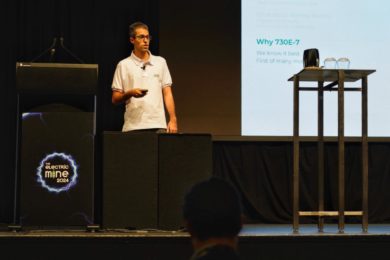Brazil’s largest mining contractor is confident it can be scaling up a new battery-electric hybrid truck platform and retrofitting the country’s second biggest surface mine diesel vehicle fleet in the next two years, The Electric Mine 2024 heard. “We really want to get into a future where mining becomes safe, intelligent and sustainable,” U&M Mineração e Construção Project Coordinator Lucca Machado said at the event in Perth, Western Australia.
“We see that our initiatives, along with other projects around the world, are going to help us get there. And hopefully sooner than later.”
U&M has been working for about seven years on heavy vehicle automation and in 2020 it initiated a hybrid diesel-electric truck program focused, initially, on getting a suitable power-to-weight balance on a Komatsu 730 186 t truck using LFP lithium-ion battery cells made in China and hybrid platform system components developed with partners in Brazil.
The latter included Semikron Danfoss on the truck’s DC-to-DC converter; transformer and reactor specialist AQ Trafotek; and local electromobility hardware and software start-ups MVP e-solutions and EVPV Power.
U&M has two autonomous trucks running at a gold-mining client’s site in Brazil.
Lucca Machado, part of the third generation of the Machado family that owns U&M, said the company was also “trying to explore as much as possible the synergy” between autonomous and hybrid-power vehicle systems.
He said U&M was moving towards validation of its hybrid platform system at a client site by the end of 2024.
“We are hopeful that we can get in the next couple of months this [test 730] truck running at our proving ground. After that focus will shift to stress-testing the truck at one of our mine sites in Brazil. That’s where we see whether the technology is working or not. That’s where we see the performance of the new components. Next year is where we really focus on system optimisation. And there is quite a bit to be done.”
Machado said downsizing the truck’s diesel engine – perhaps by as much as 50% to circa-1,000 horsepower – would be part of the project’s ongoing optimisation focus. As would exploring the impact and timing of different battery charging options, including regenerative braking, on the energy profile of a truck in a production cycle.
“Our focus is to get that done at the beginning of 2025 and after that moving into scale,” he said. “We know that [scaling] is tough. We have quite a lot of experience with our autonomous project. But we are confident that, working with the partners that we have, we can bring this to our clients at the end of next year.”
U&M has more than 90 Komatsu 730 trucks in a total fleet of about 800 heavy and support vehicles.
It wants to develop a commercial 730 truck retrofit kit costing under US$200,000, sans the battery pack. “Then the battery will change depending on the chemistry we use and we know that within a couple of years it’s going to be a different one,” Machado said. “We have a bit over 250 trucks that have 10-20 years of life ahead of them and really running into the risk of being technologically obsolete [in future]. So that’s a very big motivation for us, along with increased performance [of the trucks]. We’re aware there are quite a few challenges with these new technologies.”
He adds: “And we see really that the biggest one of them is trying to fit with the current day operational profile of the trucks. These trucks are running 24-7. They are very reliable and very flexible. If we’re going to help our clients get to their 2030 [decarbonisation] goals we need to have different strategies. There isn’t going to be one solution that fits everything. As a mining contractor charging infrastructure is a challenge. We have quite a few short-term contracts. So we have to go to one place and next year we will be somewhere else. So the hybrid retrofit we’ve been working on … is a really natural first step for decarbonisation because it’s a simple solution and we can make preparations now.”
This story was written by Richard Roberts of InvestMETS, one of The Electric Mine 2024 Supporting Partners










